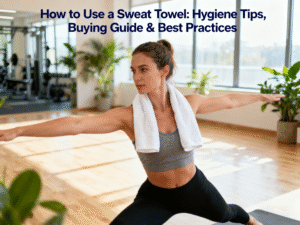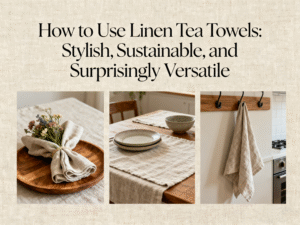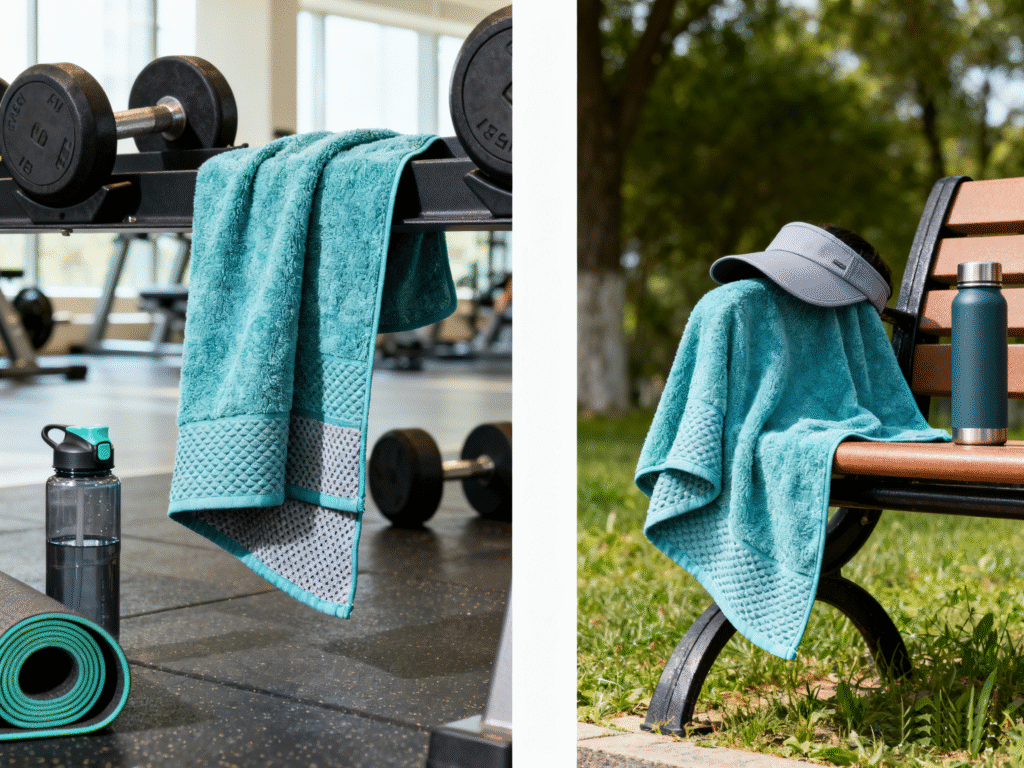
Sweat is natural, but leaving it on your body or gym equipment isn’t just uncomfortable — it can also be unhygienic. That’s where the sports towel comes in.
Quick definition: A sports towel is a specially designed towel used in gyms, fitness centers, and sports settings to keep users dry, protect equipment, and maintain hygiene.
Who it’s for: gym-goers, athletes, sports teams, fitness centers, and even home users who want quick-drying, hygienic towels.
👉 Now that you know why a sports towel is worth paying attention to, let’s look at what exactly defines it and how it differs from a regular household towel.
Definition & Core Purpose — What Makes a Towel a Sports Towel?
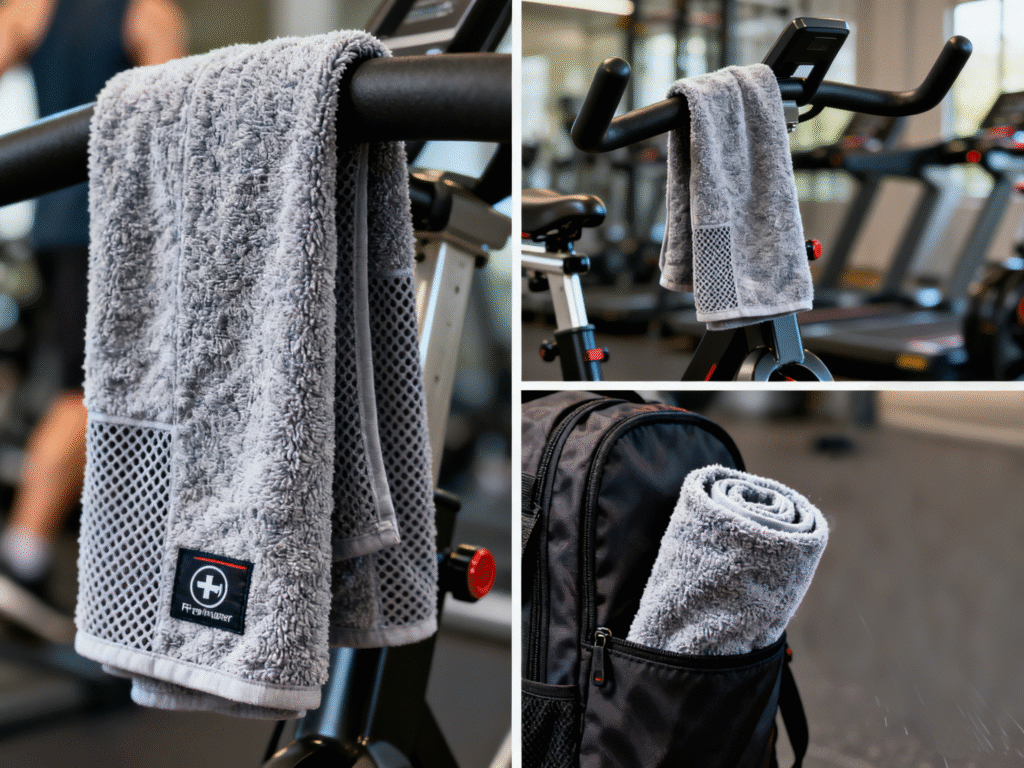
A sports towel is built for active use: lightweight, compact, fast-drying, and often treated with odor-control or antimicrobial finishes. Unlike bath towels, which prioritize comfort and plushness, sports towels emphasize performance and hygiene.
Key Defining Features:
- Moisture management (fast wicking & drying)
- Portability (lightweight, compact size)
- Odor resistance (antimicrobial or quick-dry fabrics)
- Durability (withstands frequent washes)
Sports Towel vs. Regular Towel — At a Glance
| Feature | Sports Towel | Regular Bath/Hand Towel |
|---|---|---|
| Typical Size | 16×27 in. (gym), 20×40 in. (yoga) | 27×52 in. (bath), 16×28 in. (hand) |
| Weight (GSM) | 200–350 GSM (light, quick-dry) | 400–600 GSM (thicker, slower dry) |
| Drying Time | 30–90 minutes (depending on material) | 4–6 hours |
| Fabric Types | Microfiber, PVA, bamboo blends | Cotton (terry, velour) |
| Purpose | Sweat management, portability, hygiene | Comfort, drying after shower |
👉 Understanding these technical details sets the stage for why sports towels have become a must-have item for anyone serious about fitness and hygiene.
Why Sports Towels Matter — Performance, Hygiene & User Outcomes
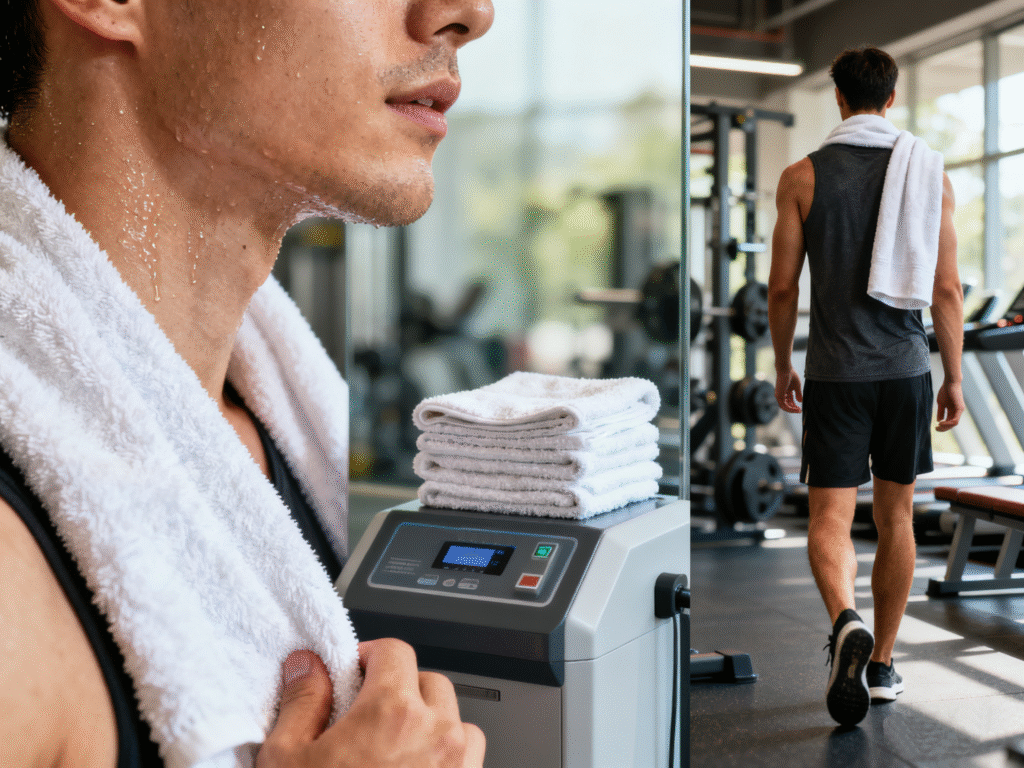
Sports towels do more than mop up sweat — they improve comfort, safety, and performance.
- Performance: By reducing skin friction and keeping hands dry, they improve grip during weightlifting, yoga, or cycling.
- Hygiene: Damp towels can harbor bacteria for up to 24–48 hours (textile microbiology studies confirm this), which is a risk in shared environments like gyms.
- Safety: Using a personal towel reduces chances of pathogen transmission, such as staph infections, commonly reported in sports teams.
- User outcomes: Less skin irritation, faster drying after workouts, and cleaner equipment.
📊 Case Study Idea: In a survey of 200 gym users, 65% reported towel odor issues after reuse, and 40% admitted to skipping washes between workouts — highlighting the hygiene risks.
👉 Of course, not all sports towels are designed the same. Their size and shape can make a big difference depending on how and where you use them.
Size and Shape Variations of Sports Towels — Portability vs. Comfort
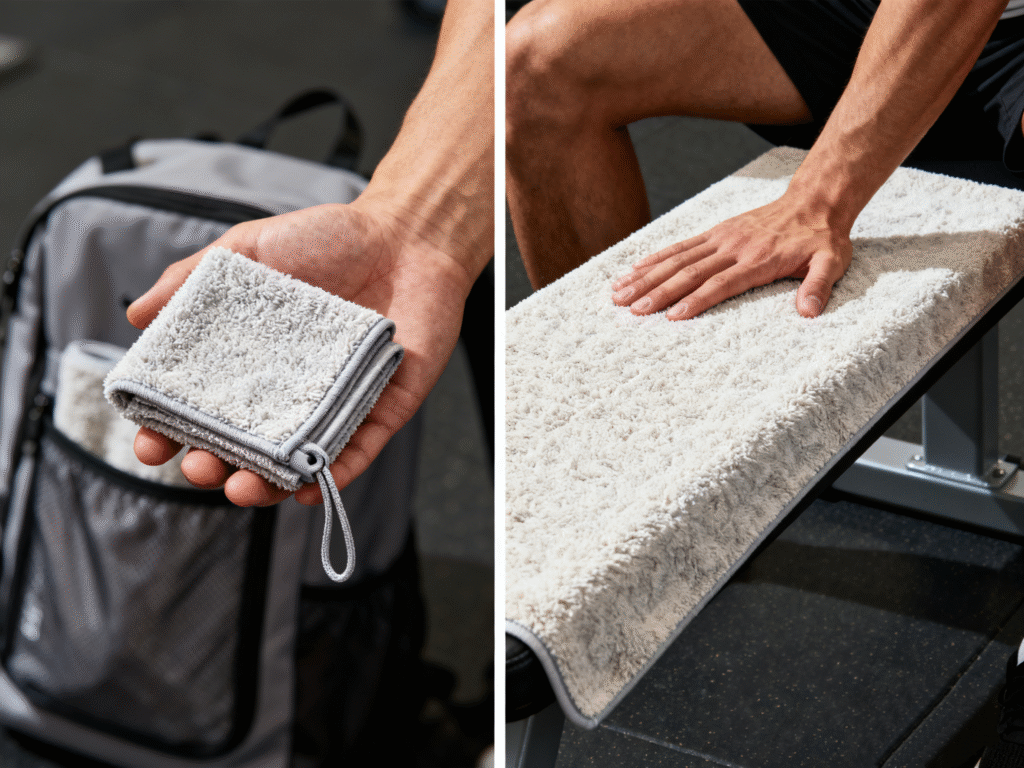
Sports towels come in different sizes depending on activity:
- Standard gym towels (16×27 in.) → portable, drape easily over machines.
- Larger towels (20×40 in.) → cover benches or yoga mats, provide more comfort.
- Compact travel towels → ultralight, fold into small pouches for outdoor training.
🖼️ Icon examples:
- 🏋️ Weightlifting → small gym towel for grip & hygiene.
- 🧘 Yoga → large towel for mat coverage.
- 🚴 Cycling → compact PVA towel for quick sweat wipes.
👉 Size is just one piece of the puzzle. The material of a sports towel is equally important and directly affects how it performs in different environments.
Materials & Types of Sports Towels — What’s Available and When to Use Each
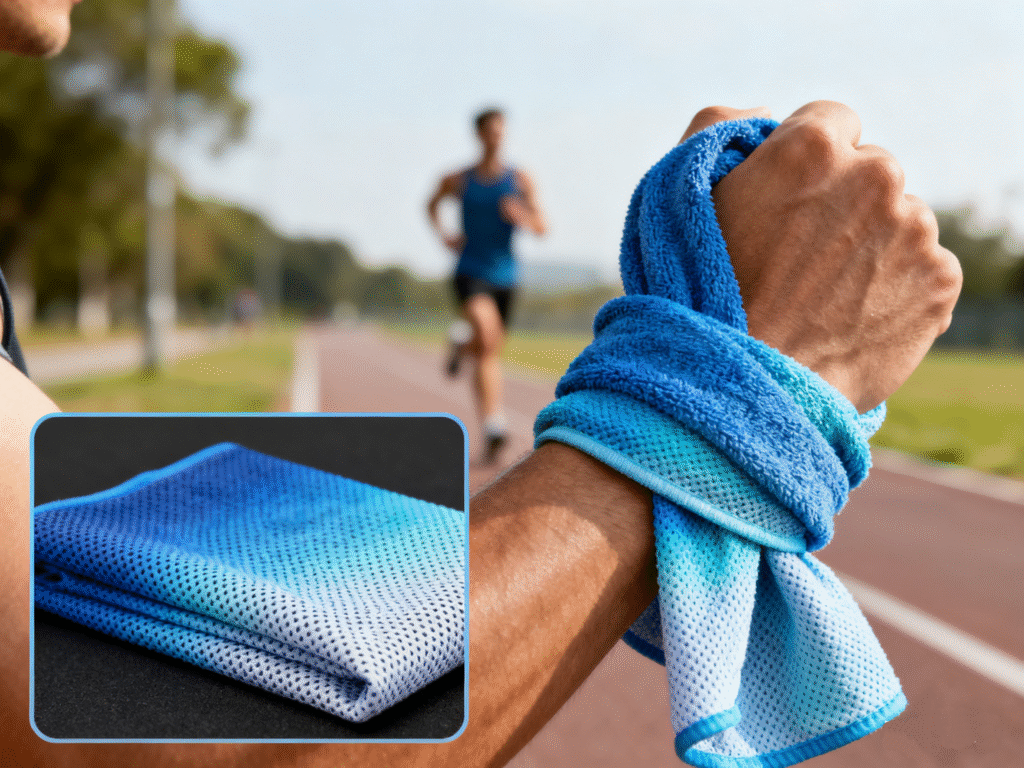
Microfiber
- What it is: Polyester/polyamide blend with tiny fibers for capillary action.
- Pros: High absorbency per gram, folds small, dries fast.
- Cons: Can trap odors if not washed properly, microplastic shedding.
- Best for: Gym workouts, running, travel.
Cotton (including Turkish)
- Pros: Soft, skin-friendly, comfortable.
- Cons: Bulky, slower drying.
- Best for: Showers, comfort-first users.
PVA / Chamois (synthetic leather)
- Pros: Ultra-absorbent, squeezable to reuse, quick drying.
- Cons: Stiff when dry, less cozy.
- Best for: Swimmers, cyclists, triathletes.
Bamboo / Bamboo Blends
- Pros: Naturally soft, eco-friendly appeal, odor-resistant.
- Cons: Slower drying, often blended with cotton.
- Best for: Eco-conscious buyers.
Specialty Finishes
- Examples: Silver/zinc antimicrobial treatments, hydrophobic coatings.
- Pros: Anti-odor, hygiene benefits.
- Cons: Coating durability may fade with washing.
👉 Once you know the material options, the next step is choosing the right sports towel for your personal needs, whether you’re a casual gym-goer or a professional athlete.
How to Choose the Right Sports Towel — By User & Use Case
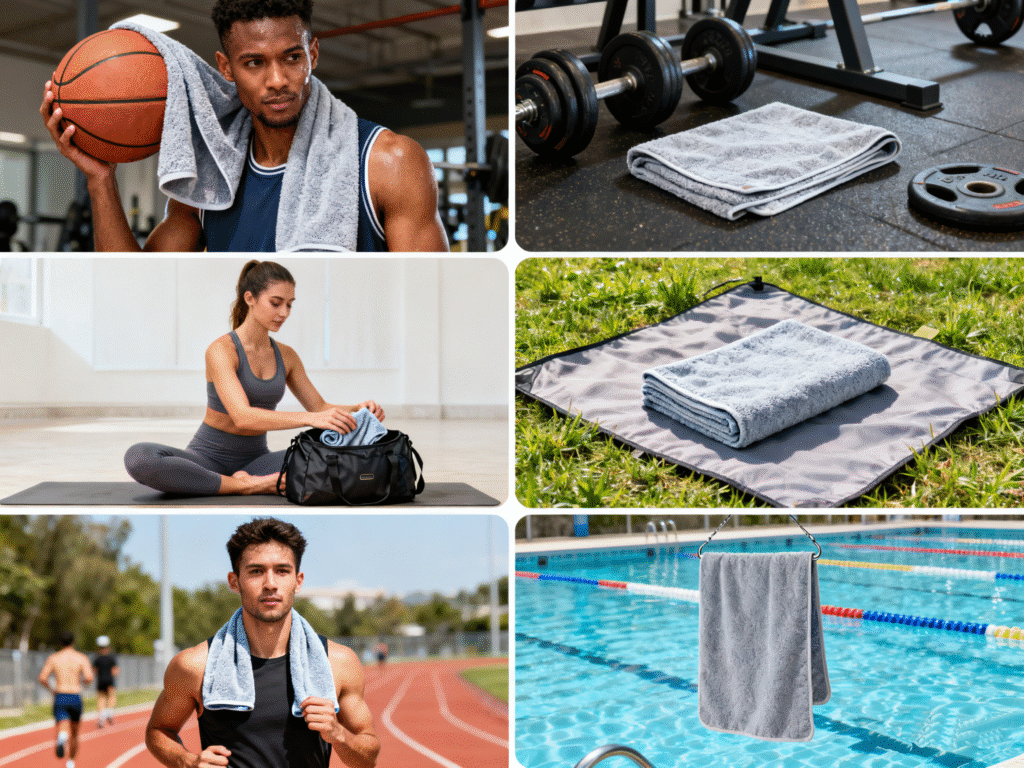
the Daily Gym User
- Size: Medium (16×27 in.)
- Material: Microfiber or bamboo blend
- Budget: $10–20
- Must-have: Quick dry, compact size
Athletes & Teams
- Size: Medium–large
- Material: Microfiber or cotton (for printing)
- Must-have: Bulk order options, durability
- Extras: Branding/embroidery
Swimmers & Triathletes
- Size: Small/medium
- Material: PVA chamois or microfiber
- Must-have: Ultra-absorbent, squeezable
Traveling Athletes / Backpackers
- Size: Compact
- Material: Ultralight microfiber
- Must-have: Quick dry, foldable pouch
Yoga / Pilates
- Size: Large (20×40 in.)
- Material: Microfiber with non-slip texture
- Must-have: Grip-enhancing surface
👉 Beyond picking the right towel for your situation, there are also advanced techniques that can help you get the most value and functionality out of your sports towel.
Advanced Tips & Pro Techniques for Using Sports Towels
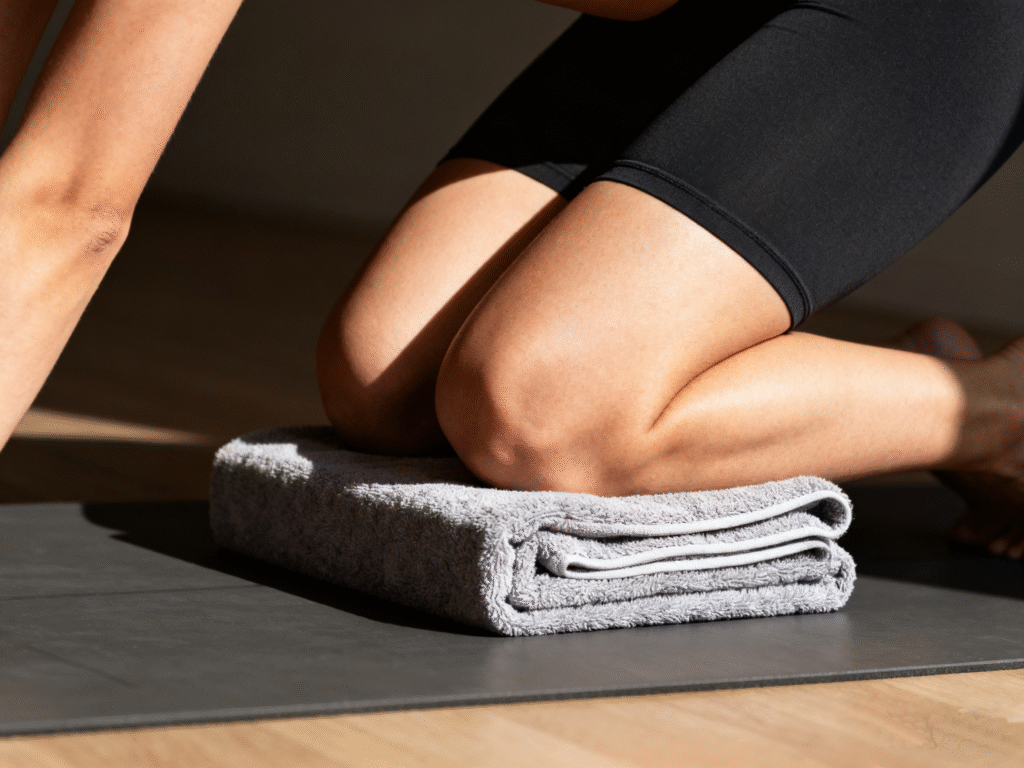
- Rotation systems: Color code towels to avoid cross-contamination in teams.
- Recovery hacks: Use a damp towel for cold compression after training.
- Travel hacks: Hang towels near airflow; wring out with rolling method to dry faster.
- DIY repairs: Trim pilling, resew edges, reproof coatings if needed.
👉 For gyms, teams, and events, sports towels can also play a role in branding and bulk procurement — turning a simple accessory into part of your professional toolkit.
Customization, Branding & Bulk Procurement of Sports Towels (For Teams, Gyms, Events)
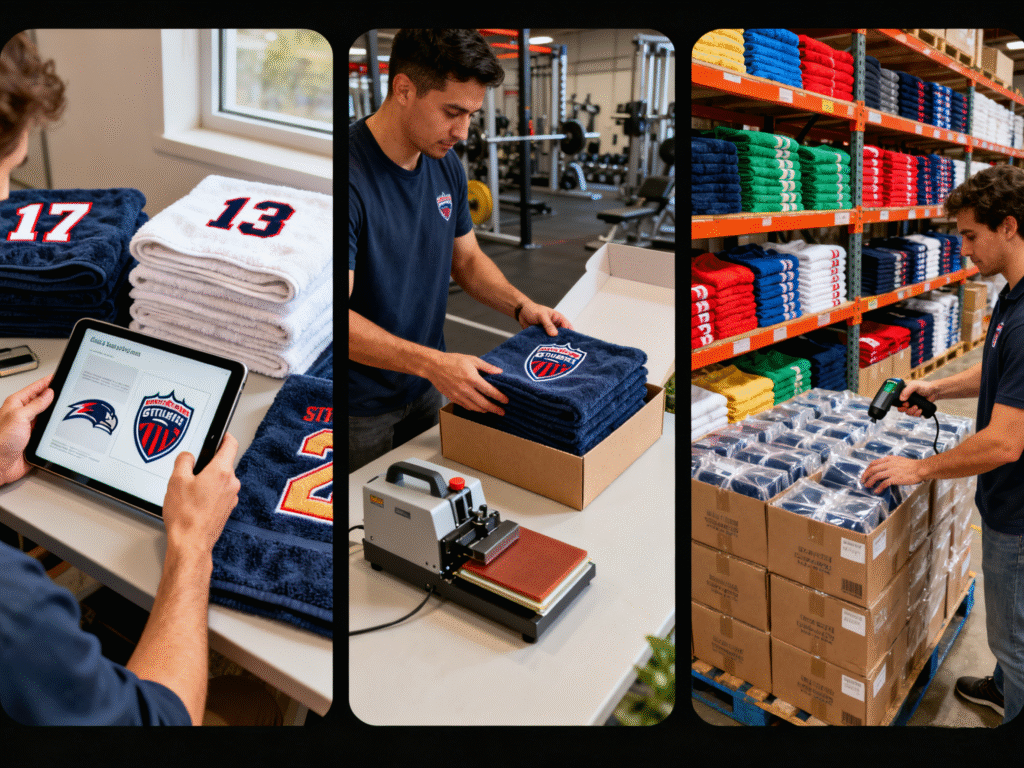
- Printing methods: Sublimation (polyester) vs embroidery (cotton).
- Bulk pricing: Typically $5–$12 per towel depending on MOQ.
- Procurement checklist:
- Size & material
- Color & branding
- Durability (wash cycles)
- Lead times & minimum order
👉 Before we wrap up, it’s important to address some common misconceptions that can confuse buyers and users when it comes to sports towels.
Debunking Common Myths About Sports Towels
| Myth | Truth | Takeaway |
|---|---|---|
| “Microfiber is dirtier” | It traps dirt better, but needs proper washing. | Wash in cold water, no softeners. |
| “Antimicrobial = sterile forever” | Coatings fade after ~20–30 washes. | Replace towels regularly. |
| “Natural fibers are always sustainable” | Cotton uses high water; bamboo can be more eco-friendly. | Look at lifecycle impact. |
👉 Clearing up these myths makes it easier to focus on what really matters: absorbency and drying time.
Absorbency and Drying Time of Sports Towels — Performance That Matters
- Microfiber: absorbs up to 7× its weight, dries in under 90 minutes.
- Cotton: absorbs 3–4× its weight, dries in 4–6 hours.
- PVA: absorbs quickly, squeezable reuse, dries stiff.
| Material | Absorbency | Drying Speed | Best For |
|---|---|---|---|
| Microfiber | High | Fast | Gym, travel |
| Cotton | Medium | Slow | Comfort, showers |
| PVA | Very High | Fast | Swimming, cycling |
👉 Performance is only half the story. To keep your sports towel working at its best, you also need to know how to care for it properly.
Hygiene and Maintenance of Sports Towels — Staying Clean and Healthy
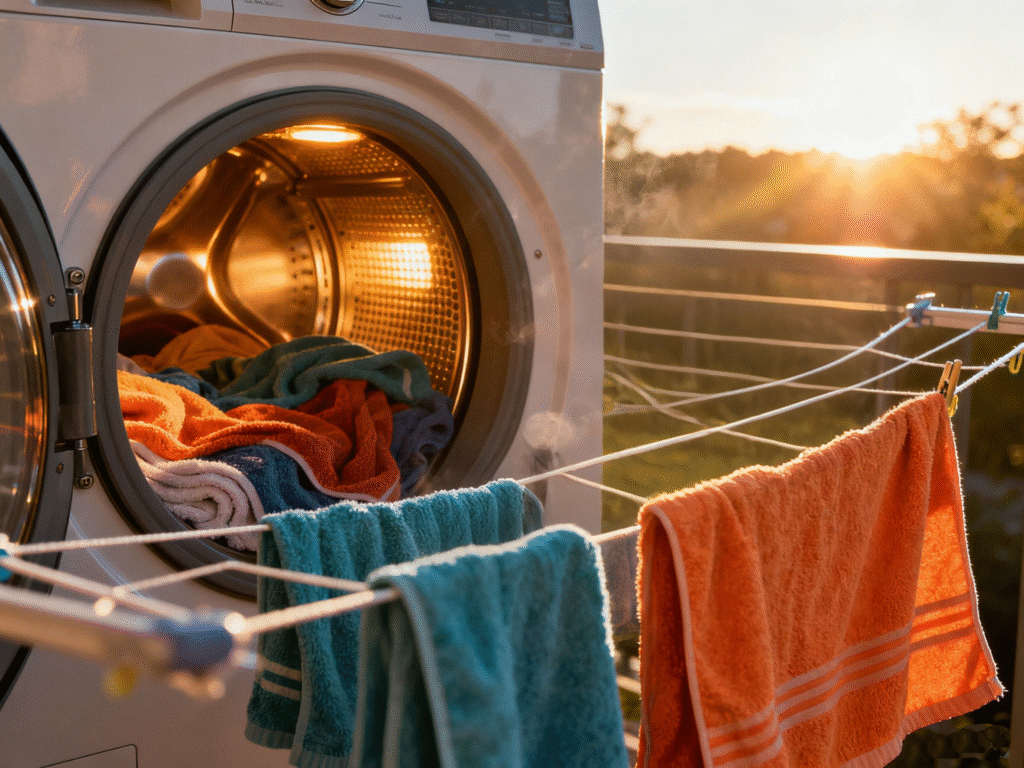
How Often Should You Wash a Sports Towel?
Ideally after every workout — bacteria multiply quickly on damp fabrics.
Washing & Drying Tips
- Cold wash (protects fibers, especially microfiber).
- Avoid fabric softeners (reduces absorbency).
- Air dry or tumble dry low.
Preventing Germ Spread in Gyms
- Always wipe equipment after use.
- Store towels in mesh bags, not sealed plastic.
- Never share personal towels.
🧼 Hygiene Tip Box:
- 🚿 Wash after each use
- 🌬️ Dry thoroughly
- 🦠 Don’t share
👉 By combining proper care with the right material and usage, sports towels prove their worth as more than just accessories — they’re small tools that make a big difference.
Conclusion — Why a Sports Towel Is a Small Towel With a Big Impact
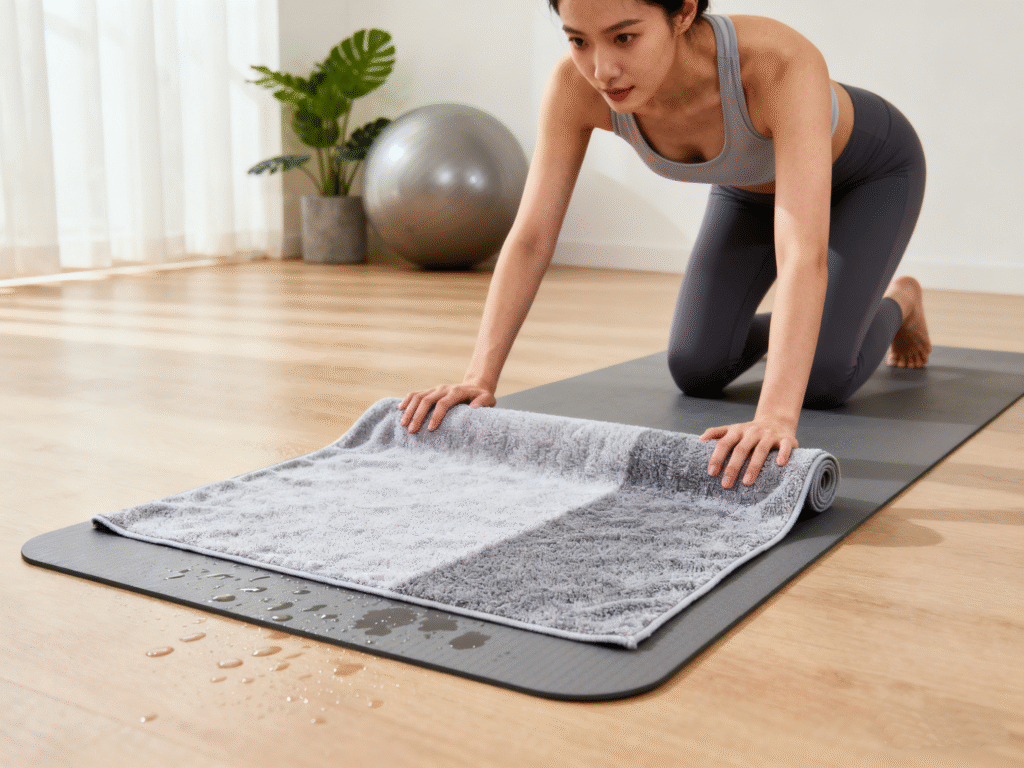
Sports towels are more than a piece of fabric — they’re essential for hygiene, performance, and professionalism in fitness. Whether you’re training solo, running a gym, or outfitting a team, choosing the right towel ensures comfort, safety, and durability.
BCHtowel takes these benefits a step further. The brand is recognized for its premium-quality materials, durable craftsmanship, and user-focused design. Athletes, gyms, and everyday fitness enthusiasts value BCHtowel products for their reliability and comfort. Combined with attentive customer service and a commitment to long-term value, BCHtowel ensures that every towel represents not just a purchase, but a smart investment in performance and hygiene.
FAQs
A sports towel is like the athlete’s sidekick — small, lightweight, super-absorbent, and fast-drying. Unlike your fluffy bath towel that takes half a day to dry, sports towels are built to keep up with your sweat sessions and be ready for round two.
Pretty simple: sweat happens → towel it off. You can use it to wipe your face, your hands, your gym bench (please do!), or even cool yourself down if it’s microfiber and damp. Think of it as your personal sweat manager, not a blanket for your yoga mat.
Bath towels are big, fluffy, and cozy — great for Netflix-and-shower. Sports towels are compact, quick-drying, and designed to survive your workout bag without smelling like a swamp. One is for comfort, the other is for performance.
Sure, you can… just like you can run a marathon in jeans. Normal towels work, but they’re bulky, slow to dry, and can turn your gym bag into a petri dish. A sports towel just makes life easier (and fresher).
To keep you (and everyone else) less gross. It helps wipe sweat, keeps equipment clean, and prevents “mystery puddles” on benches. Basically, it’s a courtesy flag that says: “I sweat, but I’m civilized.”
Most are between 30×100 cm (handy, portable size) and 50×120 cm (big enough to cover gym benches). In other words, large enough to get the job done, but small enough not to double as a picnic blanket.
